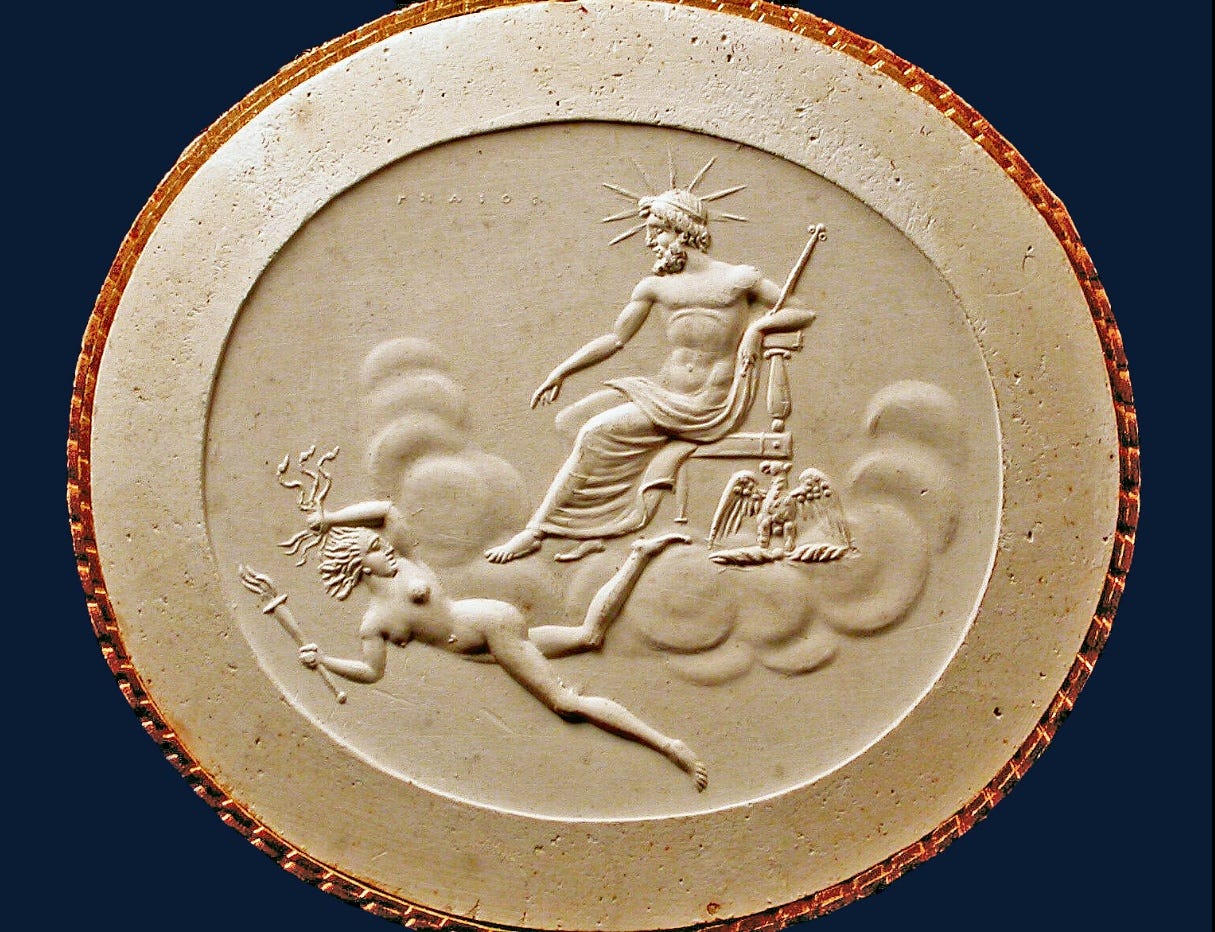Some thoughts while I continue my engagement with The Making of the Iliad…
Homer tells us that the eldest daughter of Zeus was Delusion (Ate), “who blinds all – accursed one whose delicate feet never touch the ground but walk over the heads of men, tripping up all mankind.” Iliad 19.91-4. She once even fooled Zeus, and enraged by her tricks, he grabbed her by her “lustrous tresses” and flung her from “the star-strewn heaven” (off Olympus) into the mortal realm where she has been causing havoc ever since.
Delusion is a harsh word and we should rightly eschew invoking it, or the goddess that personifies it, in explaining actions of others with which we disagree, or our own for which we wish to avoid accountability. Agamemnon did himself no favors by blaming Ate in an attempt to get himself off the hook.
But I sometimes wonder if Delusion doesn’t have a sister; softer, well-meaning and more seductive still. That would be Narrative. We are storytelling creatures. Stories are, in large part, how we understand the world psychologically and interact with it. By that I mean, reality as we perceive it is largely defined by stories, by Narrative.
Now, as a physicist, I might – or perhaps some might say should – be tempted to assign primacy to numbers in the description of reality. I once heard it said that if you cannot put a number on something, it is not truly real. Personally, I find that proposition suspect almost to the point of sinfully wondering if whoever opined that had Zeus’s eldest daughter tripping lightly over his head at the time. My weakness aside, however, the point is that a number out of context, that does not have a narrative to tell us what it means, is a number untethered from actionable reality. So Narrative may be our true patron deity, both mythologically and psychologically speaking.
The catch is, as Eric Luttrell mentioned to me, that good narratives rarely make for good explanations, and this is very true. So Narrative, whose powers are nearly unmatched, can all too easily lead us into what I call the Credibility Trap.
The trap is, how do we assess and assign credibility? In employing the scientific method, we can apply standards of applicability and repeatability that have an empirical and mathematical basis. If those standards are met, we judge the result credible until we achieve new results which meet or exceed those same standards.
In historical research, these standards can’t readily be applied in the same way. We have sources of information, but we also have narratives about those sources; their trustworthiness, their motives, what sources they had and their ability to interpret them, they’re ignorance, they’re biases and so on. All these factors go into our assessment of credibility.
As sober and careful historians, we are expected to weigh these factors carefully, but this does not make us immune to Narrative’s seductive powers. For example, we believed grave goods to be reliable indicators of the sex of the grave’s occupant, based on a cultural assumption about which artifacts are masculine (weapons) and feminine (mirrors).
That assumption underlay the narrative we constructed about the reality of Amazons. In turn, that narrative impacted our views on the credibility of sources like Herodotus. If, as sober and careful historians, we felt Amazons were at best legendary (given the nature of the stories about them), but Herodotus believed in their reality, then Herodotus was untrustworthy. So we were obliged to view with more caution, if not throw out, other things Herodotus reported if we lacked the ability to support them through other sources which we deemed more credible.
However, DNA testing became available and we discovered our assumption about grave goods is often false. Further, archeology now shows us that Herodotus knew a good deal more about Amazons than we thought he did. So the credibility of Herodotus should be reassessed.
What does this mean for the sober and careful historian? By those very terms, we mean being conservative. That is, setting a fairly high bar for the evidence we require to overturn a conclusion that has consensus support. But what sets the height of the bar?
As historians, we are captive to random chance and fate: random chance in what happens to survive; fate in terms of whether we find it. So the height of our bar depends on the credibility we assign, which in turn depends on the narrative we have built up over time, and that circles back to the results of random chance and fate.
The pickle this places us in, is that we don’t actually have a way of knowing how high we are setting our bar. The esteemed historian, Trevor Bryce, whom I very much admire, once said in regards to some hypotheses about the Trojan War that in proposing them “we are well into straw-clutching territory.”
I’m inclined to answer with all respect that in history, given the fickle nature of fate, straws are usually all we have to clutch at. So the weight we attach to each straw is crucial, and one can indeed break the camel’s back; that is, break our narrative or, as I love to say, upset the apple cart. (Yes, it’s apples all the way down. 😆) But my larger point is that Bryce set the height of his bar, by which he assigned meager weight to these “straws,” based on a narrative he believed about the Trojan War’s nature. That happens to be the very narrative I am questioning.
In saying this, I certainly do not mean to disparage Trevor Bryce. He has forgotten more about the history of ancient Anatolia then I can ever hope to learn. Rather, I merely mean to point out that narratives can lead even the best of us into what may be error (to say nothing of the lesser of us, like myself).
What then, to do? The only advice I can offer, which is neither original nor especially profound, is to keep our eyes and our minds open, and ask questions without paralyzing ourselves with indecision. All easier said than done. But as they also say, Chance favors the prepared mind.
In closing, Narrative, unlike her tricksy sister, means well, but we should be cautious in following where she leads. We may fall into the Credibility Trap.




